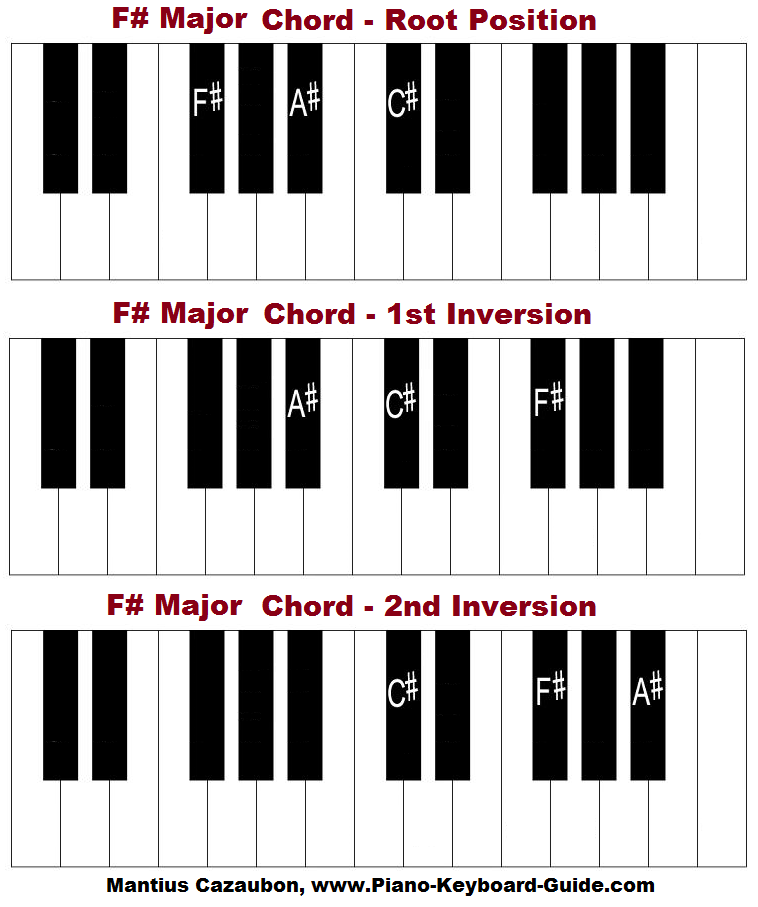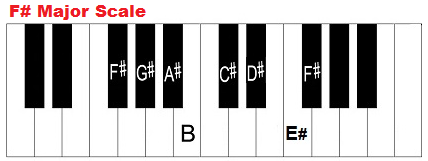On a piano, F# is the black key immediately to the right of the white F key. It is also known as Gb, the enharmonic equivalent.
Embarking on a musical journey through the landscape of a piano’s 88 keys, F sharp strikes as a note of subtly commanding presence. Found nestled between the familiar territories of F and G, the F# key bridges major and minor tonalities with dexterity.
This unique position makes it an indispensable tool for composers and musicians aiming to infuse their works with the nuanced transitions that enrich musical narratives. Whether you are a seasoned pianist or an eager beginner, understanding the placement and role of F# is crucial for mastering the keyboard’s harmonic potential. As you familiarize yourself with the geography of the piano, the F# key serves as a landmark guiding the exploration of scales, chords, and melodies that define the essence of pianistic expression.

Credit: www.piano-keyboard-guide.com
Locating F# On The Keyboard
An integral part of mastering the piano involves becoming familiar with its keys, particularly the sharp notes like F#. Knowing where F# is located is essential for playing many songs and scales. Let’s dive into the simple steps to find F# on the keyboard.
Identifying The Black Keys
Before locating F#, understanding the black keys is crucial. On a piano, black keys group in twos and threes. These patterns repeat across the keyboard.
Let’s explore:
- Two black key group: A pair sitting together.
- Three black key group: A trio bunched together.
Finding F# Among The Patterns
F# is found in the group of three black keys. It’s the first key in this trio. Use the following steps to spot F#:
- Look for the three black key group.
- Identify the very first black key of the group.
- That key is F#.
Remember, each set of three black keys has an F#. Start at middle C and move to the right to find the first F# more easily.
| Key Group | Position of F# |
|---|---|
| Three black keys | First key |
| Next group of three | First key again |
Role Of F# In Music
The role of F# in music extends beyond just being a key on the piano. Its function orchestrates the depth and emotion in compositions. Found by ascending one semitone from F, this key is essential in creating a rich tapestry of sound.
Harmonic Function Of F#
F#, or F sharp, serves as a pivotal note in many chords and scales. Its sharp quality creates tension and leads to resolution. In the scale of G major, F# is the leading tone, gravitating towards the tonic, G. As part of the F# minor chord, it forms the root, adding a somber quality to music when the chord is played.
- In a D major chord, F# is the major third, brightening the harmony.
- In an F# minor scale, it anchors the tonality with a grounding presence.
Chords and scales that incorporate F# often deliver a sense of completion and emotional fulfillment.
Genres That Frequently Use F#
F# appears across diverse music genres. Its versatility allows artists to weave different layers of sound.
| Genre | Use of F# |
|---|---|
| Classical music | Intricate melodies and dramatic key changes |
| Jazz | Complex chords and improvisation |
| Rock | Powerful guitar riffs and solos |
| Pop | Catchy hooks and chord progressions |
Each genre showcases F# in unique ways, reflecting its versatility. In classical concerts, F# often takes center stage during key modulations. Jazz musicians utilize F# to add color to their improvisations. Rock bands might rely on F# for punchy riffs. Meanwhile, pop songs often use F# to craft memorable melodies. Its adaptability makes F# a favorite among composers and musicians alike.
Playing F# In Different Octaves
Exploring the piano’s expanse, the note F sharp (F#) serves as a pivotal sound across octaves. It can lift a melody or anchor a harmony wherever it appears. F# might seem like a simple black key on the piano, but its role is vast and varied. Let’s dive into how F# resonates in different octaves from bass to treble.
F# In Lower Registers
The lower registers of the piano hold the deeper tones where F# resonates with a rich, full sound. In these octaves, F# provides a solid foundation for chords and can be pivotal in setting a song’s mood. When played in the left hand, the F# below middle C to the lowest F# on the piano gives a powerful weight to the music.
- Creates depth in musical compositions
- Used for bass lines and complex harmonies
- Often paired with lower octaves of other notes for a fuller sound
F# In Higher Registers
In the higher registers, F# sings with a crisp, clear tone that cuts through the music. Here, it often carries the melody or adds sparkle to a harmonic sequence. The F# above middle C, especially those near the piano’s top, ring out with a brightness that can lift a listener’s spirits or add tension to a piece.
- Carries the melody with clarity
- Injects energy and excitement into the music
- Allows for expressive high-pitched runs and arpeggios

Credit: www.piano-keyboard-guide.com
Famous Pieces Featuring F#
Discover the role of the F-sharp note in musical compositions. This semi-tone energizes pieces across genres. Deep dive into famous works where F# strikes a chord.
Classical Compositions With F#
F# plays a pivotal role in classical music. It can turn a melody magical. Here’s a glimpse at some classical pieces where F# shines:
- Ludwig van Beethoven’s “Moonlight Sonata”: The F# minor key stirs profound emotion.
- Frédéric Chopin’s “Nocturne in F# Major”: This piece radiates elegance with its F# major key.
- Sergei Rachmaninoff’s “Prelude in F# Minor”: F# minor sets a powerful, moody landscape.
Pop Songs That Highlight F#
Even in pop, F# stands out. Feel its impact in these chart-topping tunes:
| Song | Artist | Impact of F# |
|---|---|---|
| “Clocks” | Coldplay | F# underpins the iconic piano riff. |
| “Stay” | Rihanna feat. Mikky Ekko | Haunting F# notes add depth. |
| “Apologize” | OneRepublic | F# sets a haunting atmosphere. |
Tips For Playing F# Chords And Scales
Mastering the F# chords and scales can unlock a world of music on the piano. With a mysterious and crisp sound, the F# note is a thrilling pitch to explore. Get ready to dive into techniques that will enhance your play, giving life to melodies and harmonies alike. Whether you’re a beginner or seasoned pianist, these tips will help you navigate the F# landscape with ease.
F# Major Scale Fingering Techniques
Playing the F# major scale requires a specific set of finger movements. This ensures fluidity and accuracy in your performance. Here are some fingering techniques to help:
- Right Hand: Start with your thumb on F#, then continue with fingers 2, 3, 1 (over), 2, 3, 4, and 5 on C#.
- Left Hand: Begin with your little finger on F# and progress with fingers 4, 3, 2, 1, 3 (over), 2, and 1 on C#.
Practicing slowly and repeatedly will solidify these movements in your muscle memory. Scales build dexterity and should be practiced daily.
Chord Progressions Including F#
Chord progressions add emotion and complexity to your piano pieces. Including F# chords can add a rich layer of sound. Here are popular progressions:
| Progression | Chords Involved |
|---|---|
| I – IV – V – I | F# – B – C# – F# |
| ii – V – I | G#m7 – C#7 – F#maj7 |
| vi – IV – I – V | D#m – B – F# – C# |
Experiment with these chord progressions by playing them in different rhythms and patterns. Doing so strengthens understanding of harmony and melody interaction.
Credit: www.quora.com
Does the Location of a Piano’s Manufacture Affect Its Key Placement on the Keyboard?
The location where pianos are made does not affect the key placement on the keyboard. Regardless of where pianos are made, they all adhere to the standard key placement to ensure consistency and playability for musicians. The manufacturing location does not impact the layout of the keys on a piano.
Frequently Asked Questions On Where Is F# On The Piano
How Do You Find F# On A Piano?
To find F# on a piano, locate the group of three black keys. F# is the first black key in this cluster.
What Key Is F On The Piano?
On a piano, F is the white key immediately to the left of the group of three black keys.
What Are The Notes For F#?
The notes for an F# major chord are F#, A#, and C#. In an F# scale, the notes include F#, G#, A#, B, C#, D#, and E#.
How Do You Play An F Sharp?
To play an F sharp, on a guitar, press the second fret of the sixth string. On a piano, press the black key directly to the right of the white F key.
Conclusion
As we wrap up, finding the F# key on a piano is simple once you know where to look. It’s nestled between the F and G keys, just a half-step away. Mastering its location will enhance your playing skills and musical versatility.
So go ahead, let your fingers explore, and make beautiful music.
{ “@context”: “https://schema.org”, “@type”: “FAQPage”, “mainEntity”: [ { “@type”: “Question”, “name”: “How do you find F# on a piano?”, “acceptedAnswer”: { “@type”: “Answer”, “text”: “To find F# on a piano, locate the group of three black keys. F# is the first black key in this cluster.” } } , { “@type”: “Question”, “name”: “What key is F on the piano?”, “acceptedAnswer”: { “@type”: “Answer”, “text”: “On a piano, F is the white key immediately to the left of the group of three black keys.” } } , { “@type”: “Question”, “name”: “What are the notes for F#?”, “acceptedAnswer”: { “@type”: “Answer”, “text”: “The notes for an F# major chord are F#, A#, and C#. In an F# scale, the notes include F#, G#, A#, B, C#, D#, and E#.” } } , { “@type”: “Question”, “name”: “How do you play an F sharp?”, “acceptedAnswer”: { “@type”: “Answer”, “text”: “To play an F sharp, on a guitar, press the second fret of the sixth string. On a piano, press the black key directly to the right of the white F key.” } } ] }